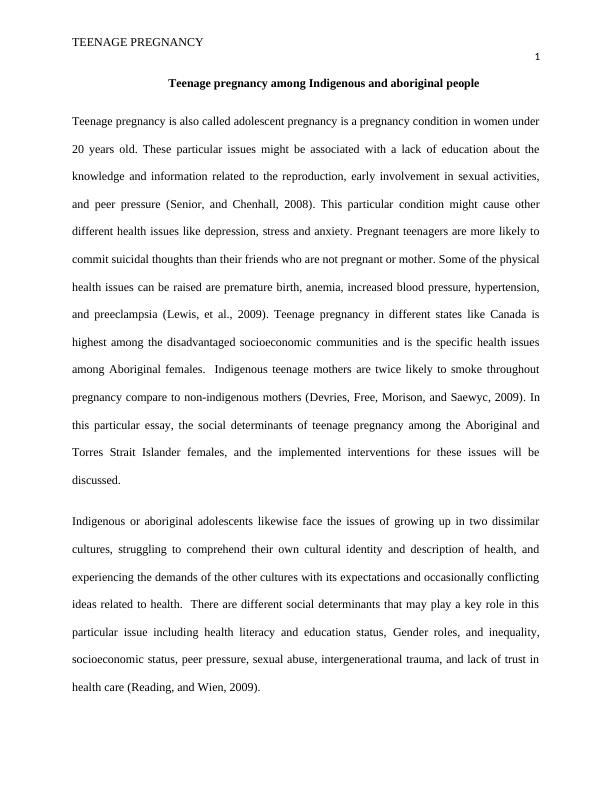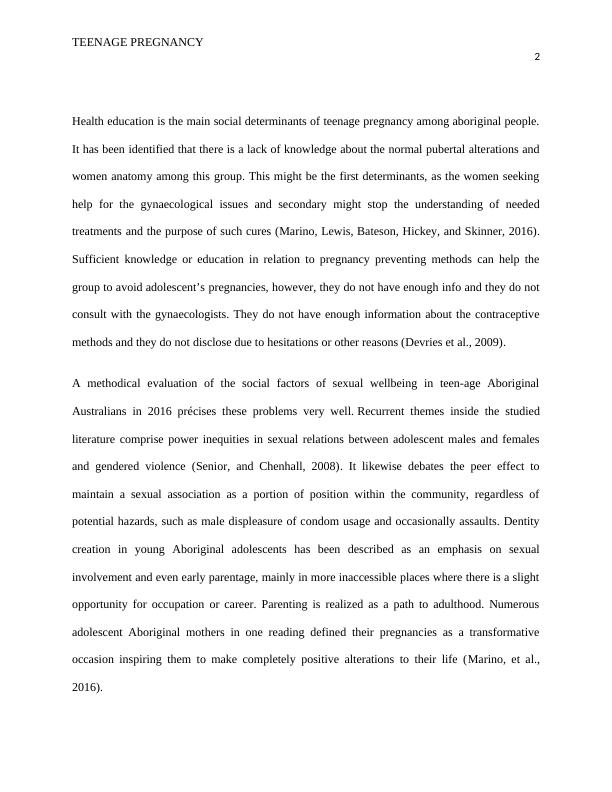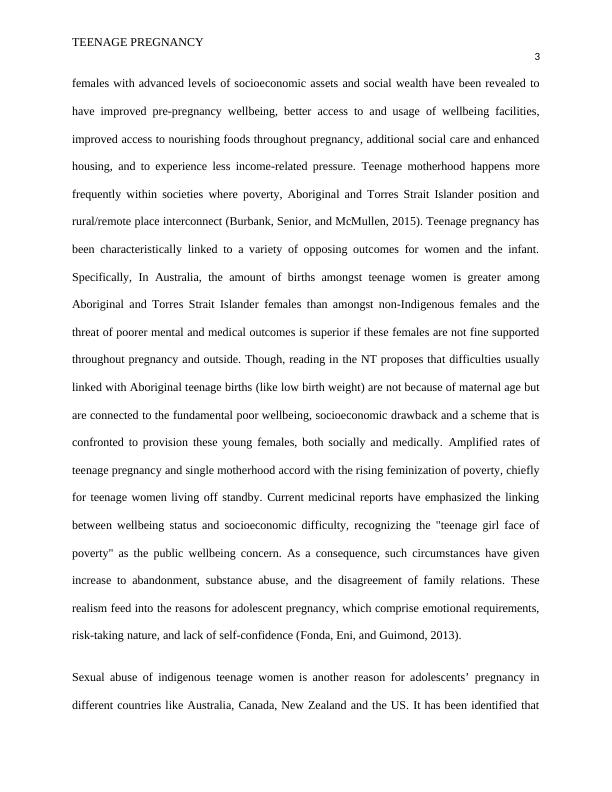Teenage Pregnancy Among Indigenous and Aboriginal People
11 Pages2902 Words42 Views
Added on 2023-03-17
About This Document
This essay discusses the social determinants and interventions for teenage pregnancy among Indigenous and Aboriginal females.
Teenage Pregnancy Among Indigenous and Aboriginal People
Added on 2023-03-17
ShareRelated Documents
Running Head: TEENAGE PREGNANCY
0
Teenage pregnancy
Essay
student
5/10/2019
0
Teenage pregnancy
Essay
student
5/10/2019

TEENAGE PREGNANCY
1
Teenage pregnancy among Indigenous and aboriginal people
Teenage pregnancy is also called adolescent pregnancy is a pregnancy condition in women under
20 years old. These particular issues might be associated with a lack of education about the
knowledge and information related to the reproduction, early involvement in sexual activities,
and peer pressure (Senior, and Chenhall, 2008). This particular condition might cause other
different health issues like depression, stress and anxiety. Pregnant teenagers are more likely to
commit suicidal thoughts than their friends who are not pregnant or mother. Some of the physical
health issues can be raised are premature birth, anemia, increased blood pressure, hypertension,
and preeclampsia (Lewis, et al., 2009). Teenage pregnancy in different states like Canada is
highest among the disadvantaged socioeconomic communities and is the specific health issues
among Aboriginal females. Indigenous teenage mothers are twice likely to smoke throughout
pregnancy compare to non-indigenous mothers (Devries, Free, Morison, and Saewyc, 2009). In
this particular essay, the social determinants of teenage pregnancy among the Aboriginal and
Torres Strait Islander females, and the implemented interventions for these issues will be
discussed.
Indigenous or aboriginal adolescents likewise face the issues of growing up in two dissimilar
cultures, struggling to comprehend their own cultural identity and description of health, and
experiencing the demands of the other cultures with its expectations and occasionally conflicting
ideas related to health. There are different social determinants that may play a key role in this
particular issue including health literacy and education status, Gender roles, and inequality,
socioeconomic status, peer pressure, sexual abuse, intergenerational trauma, and lack of trust in
health care (Reading, and Wien, 2009).
1
Teenage pregnancy among Indigenous and aboriginal people
Teenage pregnancy is also called adolescent pregnancy is a pregnancy condition in women under
20 years old. These particular issues might be associated with a lack of education about the
knowledge and information related to the reproduction, early involvement in sexual activities,
and peer pressure (Senior, and Chenhall, 2008). This particular condition might cause other
different health issues like depression, stress and anxiety. Pregnant teenagers are more likely to
commit suicidal thoughts than their friends who are not pregnant or mother. Some of the physical
health issues can be raised are premature birth, anemia, increased blood pressure, hypertension,
and preeclampsia (Lewis, et al., 2009). Teenage pregnancy in different states like Canada is
highest among the disadvantaged socioeconomic communities and is the specific health issues
among Aboriginal females. Indigenous teenage mothers are twice likely to smoke throughout
pregnancy compare to non-indigenous mothers (Devries, Free, Morison, and Saewyc, 2009). In
this particular essay, the social determinants of teenage pregnancy among the Aboriginal and
Torres Strait Islander females, and the implemented interventions for these issues will be
discussed.
Indigenous or aboriginal adolescents likewise face the issues of growing up in two dissimilar
cultures, struggling to comprehend their own cultural identity and description of health, and
experiencing the demands of the other cultures with its expectations and occasionally conflicting
ideas related to health. There are different social determinants that may play a key role in this
particular issue including health literacy and education status, Gender roles, and inequality,
socioeconomic status, peer pressure, sexual abuse, intergenerational trauma, and lack of trust in
health care (Reading, and Wien, 2009).

TEENAGE PREGNANCY
2
Health education is the main social determinants of teenage pregnancy among aboriginal people.
It has been identified that there is a lack of knowledge about the normal pubertal alterations and
women anatomy among this group. This might be the first determinants, as the women seeking
help for the gynaecological issues and secondary might stop the understanding of needed
treatments and the purpose of such cures (Marino, Lewis, Bateson, Hickey, and Skinner, 2016).
Sufficient knowledge or education in relation to pregnancy preventing methods can help the
group to avoid adolescent’s pregnancies, however, they do not have enough info and they do not
consult with the gynaecologists. They do not have enough information about the contraceptive
methods and they do not disclose due to hesitations or other reasons (Devries et al., 2009).
A methodical evaluation of the social factors of sexual wellbeing in teen-age Aboriginal
Australians in 2016 précises these problems very well. Recurrent themes inside the studied
literature comprise power inequities in sexual relations between adolescent males and females
and gendered violence (Senior, and Chenhall, 2008). It likewise debates the peer effect to
maintain a sexual association as a portion of position within the community, regardless of
potential hazards, such as male displeasure of condom usage and occasionally assaults. Dentity
creation in young Aboriginal adolescents has been described as an emphasis on sexual
involvement and even early parentage, mainly in more inaccessible places where there is a slight
opportunity for occupation or career. Parenting is realized as a path to adulthood. Numerous
adolescent Aboriginal mothers in one reading defined their pregnancies as a transformative
occasion inspiring them to make completely positive alterations to their life (Marino, et al.,
2016).
2
Health education is the main social determinants of teenage pregnancy among aboriginal people.
It has been identified that there is a lack of knowledge about the normal pubertal alterations and
women anatomy among this group. This might be the first determinants, as the women seeking
help for the gynaecological issues and secondary might stop the understanding of needed
treatments and the purpose of such cures (Marino, Lewis, Bateson, Hickey, and Skinner, 2016).
Sufficient knowledge or education in relation to pregnancy preventing methods can help the
group to avoid adolescent’s pregnancies, however, they do not have enough info and they do not
consult with the gynaecologists. They do not have enough information about the contraceptive
methods and they do not disclose due to hesitations or other reasons (Devries et al., 2009).
A methodical evaluation of the social factors of sexual wellbeing in teen-age Aboriginal
Australians in 2016 précises these problems very well. Recurrent themes inside the studied
literature comprise power inequities in sexual relations between adolescent males and females
and gendered violence (Senior, and Chenhall, 2008). It likewise debates the peer effect to
maintain a sexual association as a portion of position within the community, regardless of
potential hazards, such as male displeasure of condom usage and occasionally assaults. Dentity
creation in young Aboriginal adolescents has been described as an emphasis on sexual
involvement and even early parentage, mainly in more inaccessible places where there is a slight
opportunity for occupation or career. Parenting is realized as a path to adulthood. Numerous
adolescent Aboriginal mothers in one reading defined their pregnancies as a transformative
occasion inspiring them to make completely positive alterations to their life (Marino, et al.,
2016).

TEENAGE PREGNANCY
3
females with advanced levels of socioeconomic assets and social wealth have been revealed to
have improved pre-pregnancy wellbeing, better access to and usage of wellbeing facilities,
improved access to nourishing foods throughout pregnancy, additional social care and enhanced
housing, and to experience less income-related pressure. Teenage motherhood happens more
frequently within societies where poverty, Aboriginal and Torres Strait Islander position and
rural/remote place interconnect (Burbank, Senior, and McMullen, 2015). Teenage pregnancy has
been characteristically linked to a variety of opposing outcomes for women and the infant.
Specifically, In Australia, the amount of births amongst teenage women is greater among
Aboriginal and Torres Strait Islander females than amongst non-Indigenous females and the
threat of poorer mental and medical outcomes is superior if these females are not fine supported
throughout pregnancy and outside. Though, reading in the NT proposes that difficulties usually
linked with Aboriginal teenage births (like low birth weight) are not because of maternal age but
are connected to the fundamental poor wellbeing, socioeconomic drawback and a scheme that is
confronted to provision these young females, both socially and medically. Amplified rates of
teenage pregnancy and single motherhood accord with the rising feminization of poverty, chiefly
for teenage women living off standby. Current medicinal reports have emphasized the linking
between wellbeing status and socioeconomic difficulty, recognizing the "teenage girl face of
poverty" as the public wellbeing concern. As a consequence, such circumstances have given
increase to abandonment, substance abuse, and the disagreement of family relations. These
realism feed into the reasons for adolescent pregnancy, which comprise emotional requirements,
risk-taking nature, and lack of self-confidence (Fonda, Eni, and Guimond, 2013).
Sexual abuse of indigenous teenage women is another reason for adolescents’ pregnancy in
different countries like Australia, Canada, New Zealand and the US. It has been identified that
3
females with advanced levels of socioeconomic assets and social wealth have been revealed to
have improved pre-pregnancy wellbeing, better access to and usage of wellbeing facilities,
improved access to nourishing foods throughout pregnancy, additional social care and enhanced
housing, and to experience less income-related pressure. Teenage motherhood happens more
frequently within societies where poverty, Aboriginal and Torres Strait Islander position and
rural/remote place interconnect (Burbank, Senior, and McMullen, 2015). Teenage pregnancy has
been characteristically linked to a variety of opposing outcomes for women and the infant.
Specifically, In Australia, the amount of births amongst teenage women is greater among
Aboriginal and Torres Strait Islander females than amongst non-Indigenous females and the
threat of poorer mental and medical outcomes is superior if these females are not fine supported
throughout pregnancy and outside. Though, reading in the NT proposes that difficulties usually
linked with Aboriginal teenage births (like low birth weight) are not because of maternal age but
are connected to the fundamental poor wellbeing, socioeconomic drawback and a scheme that is
confronted to provision these young females, both socially and medically. Amplified rates of
teenage pregnancy and single motherhood accord with the rising feminization of poverty, chiefly
for teenage women living off standby. Current medicinal reports have emphasized the linking
between wellbeing status and socioeconomic difficulty, recognizing the "teenage girl face of
poverty" as the public wellbeing concern. As a consequence, such circumstances have given
increase to abandonment, substance abuse, and the disagreement of family relations. These
realism feed into the reasons for adolescent pregnancy, which comprise emotional requirements,
risk-taking nature, and lack of self-confidence (Fonda, Eni, and Guimond, 2013).
Sexual abuse of indigenous teenage women is another reason for adolescents’ pregnancy in
different countries like Australia, Canada, New Zealand and the US. It has been identified that

End of preview
Want to access all the pages? Upload your documents or become a member.
Related Documents
Aboriginal Teenage Pregnancylg...
|12
|3022
|2
Teenage Pregnancy in the UK (Doc)lg...
|9
|2969
|212
Teenager Pregnancy: Causes, Issues, and Interventionslg...
|24
|10243
|27
Aspects of Contemporary Policies Assignment PDFlg...
|9
|2586
|35
Iron Deficiency in Indigenous Pregnant Womenlg...
|16
|4098
|32
Teenage Pregnancy Policies in UKlg...
|10
|2769
|30
